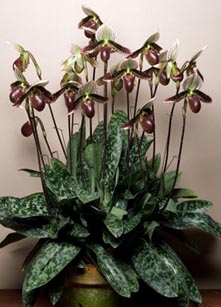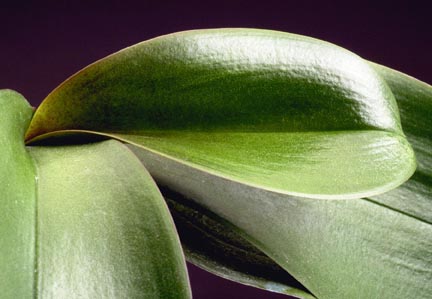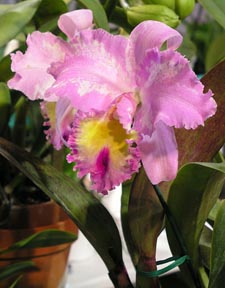Above: shopping at the 2011 Tamiami Intl. Orchid Festival
Orchid Collecting

One of the pleasures of the orchid hobby is welcoming in a new year. The holiday season gives us a chance to relax, spend time with family and friends and begin the next year feeling rejuvenated. Our orchids also begin to resume their annual cycle as days begin lengthening after the winter solstice. In January, some of our favorite, familiar orchids begin blooming and the "orchid season" picks up as we move toward spring, culminating in a slowdown by summer. Think of how lucky we orchidists are to be able to enjoy our flowers most of the year, especially if we plan our collections accordingly. It is only natural that January through May would also be the major orchid show season. If you like to shop, now is the time to get out and do it! Wherever you live in the US, you are bound to find at least one nearby orchid show to attend. Here's the current show schedule.
There is no right or wrong way to collect orchids, but there are some things to consider that will give you the most "bang for the buck". And some guidelines for selecting plants that may keep you from wasting your money.
Above right: Paph. Petula 'Crystelle' CCE/AOS

Left:
good health is evident in this Phalaenopsis leaf.
As mentioned above, you can build an orchid collection that will provide flowers throughout most of the year. Surprisingly, it doesn't even require a large number of plants. There are some lean months in late summer when we have little or nothing in bloom, but most of the year we are able to enjoy colorful orchid flowers. The easiest way to build a year-round collection is to visit as many orchid shows as you possibly can. While it is convenient to purchase orchids from catalogs or online, there is no substitute for that "love at first sight" feeling you get seeing a new species or hybrid live and in person at an orchid show. If your orchid care skills are reasonably well developed, you can be assured that the orchid will flower the following year at about the same time.
Joining a local AOS Affiliated Society also offers opportunities to see orchids in bloom throughout the year. Not only can this provide inspiration for creating a year-round collection, but sometimes club members are willing to trade divisions. Additionally, the owners of many US orchid nurseries have extensive travel schedules and give lectures across the country. The usually bring plants for sale too. Even if you end up steering your orchid collection in a specific direction, such as miniatures, pleurothallids, species-only or slipper orchids, building the base of a collection on year-round flowers will help you maintain enthusiasm as well as provide decoration for your home.
While most online orchid vendors are proud of their product and ship only the best, buying orchids in person affords some advantages. At a show or club meeting, you can select that very orchid that appeals to you, much as you would choose only ripe, unblemished fruit at a produce market. Here are a few tips that will help you select a healthy orchid that will flourish.

Right: avoid plants with flowers showing color break!
- Avoid orchid plants that are in anything less than perfect condition unless it is something that you "must have" and are willing to sacrifice the cost if the plant dies.
- Pick the plant up and inspect it. Look closely for any signs of insect pests or damage. Reject plants that show any signs of pests, even if the damage is old.
- Orchid Leaves should be turgid and not soft unless that is characteristic for the species, such as Phalaenopsis. While the actual color of an orchid leaf will vary depending on type, a medium to light green color indicates good health. Staining with purple anthocyanin pigment is typical for some orchids or can be an indication that a plant has received ample light. Anthocyanin is no cause for concern. See our Video Library for an explanation of anthocyanin.
- Orchids are only as healthy as their roots, and while it may be impolite to poke a finger into the media of a potted orchid on a vendor's bench, you can tell a lot just by studying the condition of the media itself. The media you see on the top of the pot should offer a good representation of what lies below. If it is fir bark, there should be distinct pieces that resemble the original. If it is sphagnum moss, it should still be springy and retain its original form. While live green moss may be acceptable on the media, black algae is not. Reject any plant that shows signs of weeds being plucked or cut or be prepared to repot the plant at the earliest possible time. "Good" potting media should smell more like a mushroom and less like mold.
- Unequivocally reject ANY orchid that shows a virus color break on the flowers or telltale streaking of the leaves
- Bare root orchids are a good way to purchase hard-to-find species but require special care. Some growers soak bare root imports in a 2-gallon bucket of water in which a quarter cup of sugar has been dissolved. A few drops of a vitamin supplement such as SuperThrive® can also be added. Soak the plants for a half hour then spread them on newspaper to dry. Bare root plants should be kept on the
dry side (regular misting is okay). We like to set them upright in clean empty
clay pots. When roots develop, they can be potted normally.
- Some growers keep new purchases isolated from their collection for a month or two to allow time to evaluate the health of the new plants. This may be especially important if you have any rare or irreplaceable orchids.
- Additionally, some growers test ALL new orchids for virus before placing them in the general population of a greenhouse. Virus test kits are widely available today.
Greg Allikas
February 2011

